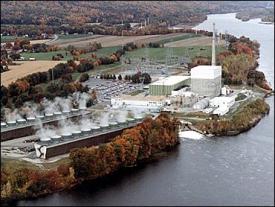|
Strontium-90 was discovered in soil that had been excavated from the area of the leak, Vermont Yankee spokesman Larry Smith said. It was noted in an analysis the company received Monday from a soil sample taken March 17, he said. The state Health Department and Nuclear Regulatory Commission were notified Thursday, he said.
Former nuclear engineer Arnie Gundersen of Burlington characterized strontium-90 as the most harmful of the radioactive materials that have been found around the leak. If it comes into contact with humans, strontium-90 concentrates in the bone and causes leukemia, he said.
"This is the worst," Gundersen said. "This is the most harmful, the hardest-to-detect and the most soluble."
The existence of strontium-90 will increase the cost of eventual decommissioning of the plant, Gundersen said.
Along with tritium, Vermont Yankee has acknowledged the discovery of cobalt-690, cesium-137, manganese-54 and zinc-65.
The state Health Department noted the strontium discovery in its updates on the tritium leak Friday. The department emphasized that the strontium has been found in the soil but not in groundwater or in drinking water.
Smith said Vermont Yankee will continue to test for various radionuclides in the soil and monitoring wells and can't say yet whether the strontium has all been discovered.
"They're going to have a lot more digging to do to capture it," Gundersen predicted.
Vermont Yankee revealed heightened levels of tritium in monitoring wells on the plant grounds in January based on samples taken in November. The company found sources of the leak in underground pipes in February and March and stopped the leaks. The company has since been excavating and removing contaminated soil.
